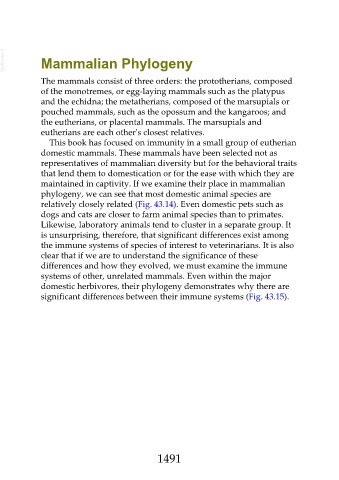Page 1491 - Veterinary Immunology, 10th Edition
P. 1491
VetBooks.ir Mammalian Phylogeny
The mammals consist of three orders: the prototherians, composed
of the monotremes, or egg-laying mammals such as the platypus
and the echidna; the metatherians, composed of the marsupials or
pouched mammals, such as the opossum and the kangaroos; and
the eutherians, or placental mammals. The marsupials and
eutherians are each other's closest relatives.
This book has focused on immunity in a small group of eutherian
domestic mammals. These mammals have been selected not as
representatives of mammalian diversity but for the behavioral traits
that lend them to domestication or for the ease with which they are
maintained in captivity. If we examine their place in mammalian
phylogeny, we can see that most domestic animal species are
relatively closely related (Fig. 43.14). Even domestic pets such as
dogs and cats are closer to farm animal species than to primates.
Likewise, laboratory animals tend to cluster in a separate group. It
is unsurprising, therefore, that significant differences exist among
the immune systems of species of interest to veterinarians. It is also
clear that if we are to understand the significance of these
differences and how they evolved, we must examine the immune
systems of other, unrelated mammals. Even within the major
domestic herbivores, their phylogeny demonstrates why there are
significant differences between their immune systems (Fig. 43.15).
1491

